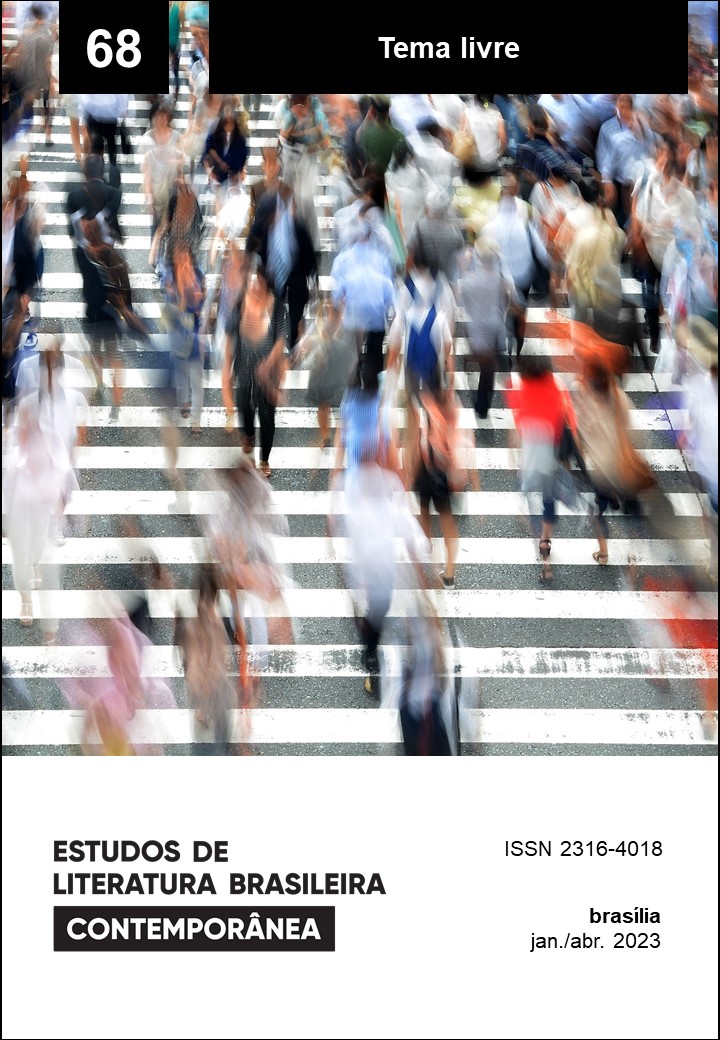Allan da Rosa and the Creation of an Afro-Brazilian Radical Imagination
Keywords:
Allan da Rosa; Black radical imagination; Black public sphere; Afro-Brazilian literature; peripheryAbstract
By creating a literature rooted in the experiences of Afro-Brazilians living in São Paulo's peripheral communities, writer Allan da Rosa articulates an imaginative space for marginalized black residents as a way to escape poverty and racism. This article frames the author's analysis of Allan da Rosa's literary works Zagaia (2007) and Da Cabula (2008) through the lens of Robin D. G. Kelley's concept (2003) of the Black radical imagination to examine how liminal spaces found in São Paulo's urban periphery become the impetus for social change. Imagination as a social practice plays a key role in the black public sphere, as Afro-descendent communities look to other historically imagined times for inspiration to conceive a future rooted in freedom. Based on these two literary works, this article analyzes the role of the imagination in the black public sphere from which Allan da Rosa's discourses emerge in terms of how his protagonists inhabit liminal spaces that continually fluctuate between the reality of urban life and the metaphysical. The purpose of this article, therefore, was to demonstrate through Zagaia and Da Cabula that the author belongs to this tradition of engaging in the Black radical imagination as a political strategy that not only resists racial and social inequity but seeks out solutions to empower afro-descendent communities through creative strategies of cultural affirmation and social mobilization.
Downloads
References
AFOLABI, Niyi (2009). Afro-Brazilians: cultural production in a racial democracy. Rochester: University of Rochester Press.
APPADURAI, Arjun (1990). Disjuncture and difference in the global cultural economy. Theory, Culture & Society, v. 7, n. 2-3, p. 295-310. https://doi.org/10.1177/026327690007002017
» https://doi.org/10.1177/026327690007002017
BAKER JR., Houston A. (1995). Critical memory and the Black public sphere. In: THE BLACK PUBLIC SPHERE COLLECTIVE (org.). The Black public sphere: a public culture book. Chicago: University of Chicago Press. p. 5-38.
DA ROSA, Allan (2007). Zagaia São Paulo: Difusão Cultural do Livro.
DA ROSA, Allan (2008). Da Cabula São Paulo: Global.
DA ROSA, Allan (2013). Pedagoginga, autonomia e mocabagem Rio de Janeiro: Aeroplano.
FARIA, Alexandre (2011). A parabélum e o passarinho: entrevista com Allan da Rosa. Darandina Disponível em: http://www.ufjf.br/darandina/files/2011/07/Entrevista-Allan-da-Rosa.pdf Acesso em: 4 jun. 2018.
» http://www.ufjf.br/darandina/files/2011/07/Entrevista-Allan-da-Rosa.pdf
FARIA, Alexandre (2015). A margem como utopia: a ginga na poesia de Allan da Rosa. In: FARIA, Alexandre; PENA, João Camillo; PATROCÍNIO, Paulo Roberto Tonani do (org.). Modos da margem: figurações da marginalidade na literatura brasileira. Rio de Janeiro: Aeroplano. p. 482-502.
GILROY, Paul (1993). The Black Atlantic: modernity and double-consciousness. Cambridge: Harvard University Press.
HABERMAS, Jürgen (1991). The structural transformation of the public sphere: an inquiry into a category of bourgeois society. Cambridge: MIT Press.
HANCHARD, Michael (1995). Black Cinderella?: race and the public sphere in Brazil. In: BLACK PUBLIC SPHERE COLLECTIVE (org.). The Black public sphere: a public culture book. Chicago: University of Chicago Press. p. 169-189.
KELLEY, Robin D. G. (2003). Freedom dreams: the black radical imagination. Boston: Beacon Press.
LOPES, Nei (2005). Kitábu: o livro do saber e do espírito negro-africanos. Rio de Janeiro: Editora Senac Rio.
MANSBRIDGE, Jane (1996). Using power/fighting power: the polity. In: BENHABIB, Seyla (org.). Democracy and difference: contesting the boundaries of the political. Princeton: Princeton University Press. p. 46-66.
ROBINSON, Cedric (1983). Black marxism: the making of the black radical tradition. Chapel Hill: University of North Carolina Press.
SCOTT, James C. (1990). Domination and the arts of resistance: hidden transcripts. New Haven: Yale University Press.
SQUIRES, Catherine R. (2002). Rethinking the black public sphere: an alternative vocabulary for multiple public spheres. Communication Theory, v. 12, n. 4, p. 446-468. https://doi.org/10.1111/j.1468-2885.2002.tb00278.x
» https://doi.org/10.1111/j.1468-2885.2002.tb00278.x
TONANI DO PATROCÍNIO, Paulo Roberto (2013). Escritos à margem: a presença de autores de periferia na cena literária brasileira. Rio de Janeiro: 7Letras.
TURNER, Victor (1994). Betwixt and between: the liminal period in rites of passage. In: MAHDI, Louise Carus; FOSTER, Steven; LITTLE, Meredith (org.). Betwixt and between: patterns of masculine and feminine initiation. Chicago: Open Court Publishing Company. p. 3-19.
WARNER, Michael (2005). Publics and counterpublics Nova York: Zone Books.
ZALUAR, Alba (1985). A máquina e a revolta: as organizações populares e o significado da pobreza. São Paulo: Brasiliense.
Downloads
Published
How to Cite
Issue
Section
License

This work is licensed under a Creative Commons Attribution-NoDerivatives 4.0 International License.
Authors who publish in this journal agree to the following terms:
a) The authors maintain the copyright and grant the journal the right of first publication, the work being simultaneously licensed under the Creative Commons Attribution License-Non Commercial 4.0 which allows the sharing of the work with acknowledgment of the authorship of the work and publication this journal.
b) Authors are authorized to enter into additional contracts separately, for non-exclusive distribution of the version of the work published in this journal (eg publish in institutional repository or as a book chapter), with authorship recognition and publication in this journal.
c) Authors are allowed and encouraged to publish and distribute their work online (eg in institutional repositories or on their personal page) after the editorial process, as this can generate productive changes, as well as increase the impact and citation of published work (See The Effect of Free Access).
d) The authors of the approved works authorize the magazine to, after publication, transfer its content for reproduction in content crawlers, virtual libraries and the like.
e) The authors assume that the texts submitted to the publication are of their original creation, being fully responsible for their content in the event of possible opposition by third parties.


